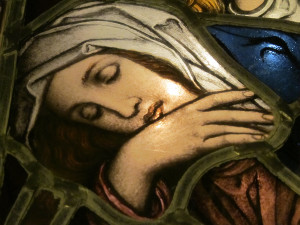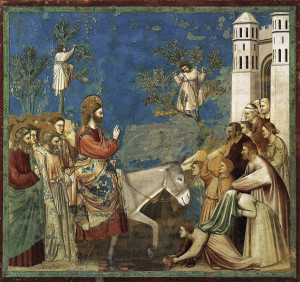
Tonight is one of the most beautiful nights of the year: Holy Thursday. A quiet and unassuming holiday/holyday, remarkable in its consistency, for the moon is always big and beautiful this night, hauntingly present, a constant companion as we make our pilgrimage in an old tradition that would have us visit three churches over the course of the evening. The world is different at night. Churches glowing from within, moonlight reflecting on columns and limestone figures. Astonishingly quiet, serene stillness.
The actual Holy Thursday mass in most churches comes around sunset. It is the Mass of the Lord’s Supper, commemorating that last supper so often depicted by artists. Jesus began by washing the feet of his disciples, a humble act accompanied by the suggestion that we, too, should not be above doing even the lowest things for others. At supper, he broke bread and passed the cup of wine: the central act of every mass.
The Holy Thursday mass I’ll attend tonight will be trilingual: English, Spanish, and Creole. It’s long and it’s crowded but I love it. It is the one mass each year where folks from so many diverse communities come together. For years I would seek out and sit next to an old Creole woman who reminded me of my grandmother, but I haven’t seen her these past two years, and so I sit there with people I do not necessarily know and I think of my grandmother and the old Creole woman who had no idea she was so important to me.
And so the First Reading will be in one language, the Second Reading in another, and the Gospel in the last of them. If you don’t know the language being spoken, you can read along on your own. And as crowded as it is, still there are two choirs: one singing in English, the other in Creole, coming together, too, for this one night each year. The Creole songs are long and mysterious. One of them is sung to the tune of “My Old Kentucky Home.” They sing in Creole while I remember what I can from Stephen Foster’s song and each year they sing that song, I think of the small scrap of paper found in Stephen Foster’s pocket after he died. On it, he had scribbled five touching words: Dear friends and gentle hearts. That’s exactly how I feel each year at this mass.
The mass ends with the transfer of the Blessed Sacrament to the chapel while the congregation sings the Pange Lingua, acapella. Its more proper name is Pange Lingua Gloriosi Corporis Mysterium, an old hymn written in Latin by St. Thomas Aquinas in the 13th century. “Mysterium” is very appropriate, for this is a night wrapped in mystery and beauty, both of which truly begin once the Pange Lingua is done. There is no real end to the mass. A small bit of chaos ensues as church workers begin to prepare for Good Friday, which is tomorrow. People get up and leave, others mill about, and it’s noisy hustle and hubbub for a good 20 minutes until, eventually, the noise fades away as the church empties to just a few hardy souls who are there to sit. Some are in prayer, some are in reflection. Most, perhaps, are like me: doing some of all those things but also just being part of something bigger than ourselves, as it should be, in the company of others.
The tradition varies, apparently. The one that my grandmother Assunta passed down to us is to visit three churches on this night. But I’ve heard of some people visiting seven churches. Both are magical numbers: 3 for the Trinity, of course, and for the three aspects of the Goddess (virgin, mother, crone), amongst other things, and 7 for more things than you might imagine: the seven sacraments, the seven days of creation, the seven sorrows of Mary, seven loaves and fishes… Still, three churches is plenty. Grandma may have been pious but she was not a martyr.
My pilgrimage each year takes me from my small old church surrounded by the tall buildings of Downtown West Palm Beach, across the lagoon to a grand church in Palm Beach that looks like it’s come out of the Vatican, to a humble church in Lake Worth. I make these rounds each year on this night, sitting, kneeling, remembering those who have gone before us doing this very same thing. This is the value of ceremony and tradition to me: this connection across time and space. And no matter where I go this night, the moon is there tagging along, trusted companion, never tiring, illuminating the night and the trees as much as the churches themselves illuminate their stained glass windows shining out from within. No one after lighting a lamp puts it under the bushel basket, but on the lamp stand, and it gives light to all in the house.
Image: The world is different at night. Courtyard at St. Edward’s Church, Palm Beach, one Maundy Thursday.


